|
|
|
Sort Order |
|
|
|
Items / Page
|
|
|
|
|
|
|
| Srl | Item |
| 1 |
ID:
138470
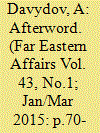

|
|
|
|
|
| Summary/Abstract |
The subject of the round table is quite timely. It is all the more important inasmuch as the assessment of the situation in East Asia given in reports and statements of experts and mass media representatives of various countries, not only foreign, but also Russian, are often based not so much on an analysis of actions of these countries, as on certain initiatives and expressions of their politicians, which sometimes have a too emotional, if not propaganda or provocative, character.
|
|
|
|
|
|
|
|
|
|
|
|
|
|
|
|
| 2 |
ID:
131617
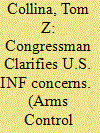

|
|
|
|
|
| Publication |
2014.
|
| Summary/Abstract |
A U.S. congressman provided new details in late April about the Obama administration's allegation that Russia may be breaching a key U.S.-Russian arms control treaty, stating that Moscow may have tested a cruise missile from a prohibited launcher. At a joint April 29 hearing of two House Foreign Affairs Committee panels, Rep. Brad Sherman (D-Calif.) said that Russia claims to have tested an intermediate-range missile for use at sea, which is allowed under the 1987 Intermediate-Range Nuclear Forces (INF) Treaty, but that Moscow used "what appears to be an operational, usable ground-based launcher," which is not allowed. Sherman said that "it appears as if [the Russians] were developing a ground-based capacity for this intermediate missile.
|
|
|
|
|
|
|
|
|
|
|
|
|
|
|
|
| 3 |
ID:
108206
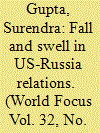

|
|
|
| 4 |
ID:
130351
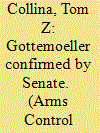

|
|
|
|
|
| Publication |
2014.
|
| Summary/Abstract |
In the face of accusations that the administration had withheld information from Congress on possible Russian Violations of an arms treaty, the Senate on March 6 voted to confirm President Barack Obama's choice to be his top arms control official. Rose Gottemoeller, first nominated in September 2012 to replace Ellen Tauscher as undersecretary of state for arms control and international security, had been serving as acting undersecretary and as assistant secretary for arms control, verification, and compliance. She was the main U.S. negotiator of the New Strategic Arms Reduction Treaty (New START), which the Senate approved in December 2010. The Senate approved Gottemoeller's nomination by a nearly party-line vote, 58-42, with the support of 50 Democrats, six Republicans, and two independents. Three Democrats and 39 Republicans were opposed. The Republicans voting for Gottemoeller were Lamar Alexander (Tenn.), Susan Collins (Maine), Bob Corker (Tenn.), Jeff Flake (Ariz.), Johnny Isakson (Ga.), and Lisa Murkowski (Alaska). The Democrats opposing her were Heidi Heitkamp (N.D.), Jon Tester (Mont.), and John Walsh (Mont.). After being approved twice by the Senate Foreign Relations Committee, once last October and again in February, Gottemoeller's nomination was held up by Sen. Marco Rubio (R-Fla.) and others over concerns that the administration had dragged its feet in informing them about Russia's possible violation of the 1987 Intermediate-Range Nuclear Forces (INF) Treaty. (See ACT, March 2014.) In a Feb. 28 statement, Rubio and Sens. John Cornyn (R-Texas) and James Risch (R-Idaho) accused Gottemoeller of "failing to quickly pursue evidence of Russia's [non]compliance with multiple arms control agreements and her delay in making the Senate aware of these violations." The three senators also said they were "frustrated" that the administration did not make a written commitment that "any future U.S. nuclear reductions would be carried out only through a treaty subject to the advice and consent of the Senate" and not by unilateral or other means that did not involve a treaty, such as reciprocal reductions carried out by the United States and Russia in 1991. At Gottemoeller's confirmation hearing Sept. 26, Rubio pressed her on the issue of unilateral cuts. Gottemoeller replied that the administration had already begun to pursue an arms control treaty with Russia, a process she described as "a difficult slog." She said that "unilateral reductions are not on the table," but did not rule them out in the future. (See ACT, November 2013.)
|
|
|
|
|
|
|
|
|
|
|
|
|
|
|
|
| 5 |
ID:
131339


|
|
|
|
|
| Publication |
2014.
|
| Summary/Abstract |
One of the central debates in contemporary international relations scholarship concerns the issue of whether balancing has occurred in response to US-based unipolarity, and if it has, how this should be characterised. Existing research has seen analysts argue that major power responses to unipolarity can be placed in one of either three categories: an absence of balancing, soft balancing, and hard balancing. This article contributes to the scholarly literature by providing a case study of hard internal Russian balancing against the US's development and deployment of Ballistic Missile Defense (BMD) systems during the Bush Administration (2001-08). Russian hard balancing against the US has involved: (1) fielding new strategic nuclear and conventional weapons equipped with BMD countermeasures, and, relatedly, (2) making changes in military doctrine. As a result, security dilemma dynamics are increasingly in evidence in US relations with Russia.
|
|
|
|
|
|
|
|
|
|
|
|
|
|
|
|
| 6 |
ID:
127714
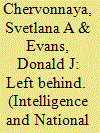

|
|
|
|
|
| Publication |
2014.
|
| Summary/Abstract |
Although the story of the role of the Special Trade Delegation of the Russian short-lived Far Eastern Republic during the Washington Conference on Naval Disarmament of 1921-22, seems to be well-known from its many Western accounts published since 1922, a recent search in the records of the Russian Communist Party has uncovered many hitherto unknown or obscure details that shed the light on the fascinating intelligence origins of the secret documentation, which the delegation made public during the conference. Particularly, the Russian records indicate the central role of one of the delegates, Boris Skvirsky, who would be left behind in the United States to become the Soviet unofficial representative and back channel during the years of non-recognition of the Soviet Union by the United States.
|
|
|
|
|
|
|
|
|
|
|
|
|
|
|
|
| 7 |
ID:
127857


|
|
|
|
|
| Publication |
2013.
|
| Summary/Abstract |
In February 1993, Russia and the United States signed an agreement on the disposition of highly enriched uranium (HEU) extracted from Russian nuclear weapons.[1] Under the terms of the deal, Russia undertook to down-blend 500 tons[2] of HEU, enough to build 20,000 nuclear warheads, over a 20-year period. The two sides agreed that the resulting low-enriched uranium (LEU) would be used as fuel by nuclear power plants in the United States, hence the informal name of the program, "Megatons to Megawatts."
In January 1994, Russia's Techsnab-export (Tenex) and the United States Enrichment Corporation (USEC), the state-run companies authorized by their respective governments to implement the deal, signed the contract. In the U.S. case, that meant that USEC was a supplier of enriched uranium to private utilities. According to assessments made at the time, the value of the entire program was expected to reach about $12 billion.
|
|
|
|
|
|
|
|
|
|
|
|
|
|
|
|
| 8 |
ID:
130017
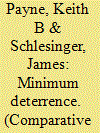

|
|
|
|
|
| Publication |
2014.
|
| Summary/Abstract |
Minimum Deterrence proposals claim that a relatively small number of nuclear weapons, measured in single digits to hundreds, is an adequate nuclear force for all pertinent U.S. deterrence missions, including extending U.S. nuclear deterrence coverage to U.S. allies. The vulnerability of an adversary's population and economy to nuclear weapons and the assumed high value of these targets to opposing leaders is the basis for the confident claims of Minimum Deterrence proponents that U.S. deterrence requirements can be met with a small number of nuclear weapons.
Contemporary proponents of Minimum Deterrence often argue that reducing to low nuclear force levels would:
1. provide deterrence that is more "stable" and greater safety than otherwise would be the case;
2. facilitate nuclear arms control agreements and successful non-proliferation policies;
3. provide substantial savings in the defense budget; and,
4. help create the conditions necessary for a more peaceful world order and help realize the goal of eliminating nuclear weapons entirely, i.e., "nuclear zero."
Recently, some U.S. officials and serving military officers have openly expressed support for the basic points and recommendations of Minimum Deterrence. Given the increased visibility of Minimum Deterrence and its potential to shape forthcoming U.S. policy decisions, it is important to identify the fundamental assumptions, logic and related conclusions of Minimum Deterrence proposals, and determine whether they are sound and consistent with available empirical evidence.
Minimum Deterrence claims generally are predicated on the following series of eight interrelated propositions:
v Deterrence will function reliably and predictably at low U.S. nuclear force numbers, now and in the future. U.S. conventional forces can substitute in many cases for nuclear forces to meet U.S. deterrence goals.
v Nuclear deterrence considerations no longer are pertinent to U.S. relations with Russia and China.
v Nuclear weapons are irrelevant to today's most pressing security threat-weapons of mass destruction (WMD) terrorism.
v Deterrence considerations alone determine the size and composition of the nuclear force requirements.
v Ballistic missile submarines (SSBNs) will remain invulnerable for 30 to 50 years. So, a small SSBN fleet can provide most or all of the nuclear capability needed for U.S. deterrence needs, now and in the future.
v The number of nuclear weapons and the risk of accidents and crises are directly correlated (more nuclear weapons means increased risk, while a decrease in their number reduces the risk).
v U.S. nuclear force reductions are essential to, and will strengthen, nonproliferation efforts; reductions also will facilitate further arms control progress. The Nuclear Non-Proliferation Treaty (NPT) requires U.S. movement toward nuclear disarmament.
v A small number of nuclear weapons is adequate for deterrence; thus U.S. defense spending can be reduced considerably by reducing nuclear forces.
Not all proposals for Minimum Deterrence include each of the eight elements. Several are of more recent vintage. But, a systematic examination reveals that these elements, implicitly or explicitly, are part of the contemporary Minimum Deterrence narrative.
The Obama administration's expressed policy positions undergirding its initiatives for nuclear reductions implicitly or explicitly reflect some, but not allof these eight Minimum Deterrence points. Particularly apparent in this regard is the presumed ability to predict with confidence and precision how deterrence and extended deterrence will work at much lower U.S. nuclear force levels.
Each of these eight points is described and critically examined here.
|
|
|
|
|
|
|
|
|
|
|
|
|
|
|
|
| 9 |
ID:
132467
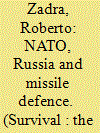

|
|
|
|
|
| Publication |
2014.
|
| Summary/Abstract |
Talks on NATO-Russia missile-defence cooperation were suspended in April during the crisis over Crimea. In retrospect, the window for a real breakthrough had closed some 18 months earlier.
After three and a half years of difficult discussions, the project exploring NATO-Russia missile-defence cooperation is not only suspended, but has probably reached its end. The initiative was an attempt to overcome Cold War thinking and realise the vision of the 2010 NATO-Russia Council Lisbon Summit: a 'true strategic and modernised partnership', and 'a common space of peace, security and stability in the Euro-Atlantic area'.
|
|
|
|
|
|
|
|
|
|
|
|
|
|
|
|
| 10 |
ID:
133636
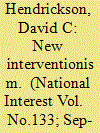

|
|
|
|
|
| Publication |
2014.
|
| Summary/Abstract |
WHEN HE RAN for president in 2008, Barack Obama promised a new era of restraint in U.S. foreign policy. And in some respects, he has indeed been more restrained than his predecessor. But those looking for a reconsideration of America's universalist ambitions have been disappointed by Obama's record. Where it has mattered, there has been no retreat from the revolutionary ends to which George W. Bush committed the United States in his second inaugural address in 2005. Thus Obama (after much agonizing) threw in his lot with those seeking to overthrow Libya's Muammar el-Qaddafi by force. Thus Obama called for Bashar al-Assad to leave, encouraged "allied" efforts to overthrow him and made negotiations to end the civil war in Syria dependent on his departure. And thus the Obama administration (with the president himself curiously in the shade) played a key role in supporting the Maidan's overthrow of Ukraine's elected president, Viktor Yanukovych
|
|
|
|
|
|
|
|
|
|
|
|
|
|
|
|
| 11 |
ID:
124329
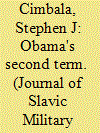

|
|
|
|
|
| Publication |
2013.
|
| Summary/Abstract |
The second term of the Obama administration will doubtless see efforts by the United States to move forward its nuclear arms control and disarmament agenda, especially with Russia. However, there is no certainty of accomplishment in this regard, and much depends upon the political chemistry between a reelected U.S. President Barack Obama and a re-reelected Russian President Vladimir Putin after 2012.1 This discussion considers the political setting and military options for post-New START strategic nuclear arms reductions, as well as other military-strategic and political issues within which U.S., Russian, and NATO nuclear arms control options are embedded.
|
|
|
|
|
|
|
|
|
|
|
|
|
|
|
|
| 12 |
ID:
104555
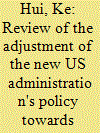

|
|
|
| 13 |
ID:
130274


|
|
|
|
|
| Publication |
2013.
|
| Summary/Abstract |
Since President Obama delivered his Prague speech four years ago, the prospects for nuclear disarmament and nonproliferation have actually not become more straightforward. This is partly due to the current state of international relations. Financial and fiscal frustration has beleaguered both the United States and the European Union (EU), and global economic growth has widely slowed. With China becoming more confident and the second-biggest economic entity in 2010, the distrust between Washington and Beijing continues to rise. Tensions over the past years concerning the change of regimes in West Asia and North Africa, the so called "Arabic Spring," as well as the U.S. "rebalancing" in East Asia further strain international relations. U.S.-Russia relations also suffer. Although the two countries brokered the new START Treaty of 2010, momentum has slowed on establishing deeper nuclear cuts. Given their different positions over the recent turbulence in Libya and the ongoing conflict in Syria, it is improbable that the United States and Russia could strategically "reset" relations to move down the road of nuclear disarmament.
|
|
|
|
|
|
|
|
|
|
|
|
|
|
|
|
| 14 |
ID:
112168
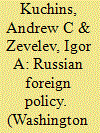

|
|
|
| 15 |
ID:
132782
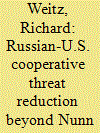

|
|
|
|
|
| Publication |
2014.
|
| Summary/Abstract |
The crisis in Ukraine probably has ruined prospects for another formal Russian-U.S. arms control agreement during the Obama administration's second term. Even before the crisis over Crimea, Russian and U.S. negotiators differed sharply on their preferred outcomes for reducing their strategic nuclear forces further, eliminating or consolidating nonstrategic nuclear weapons in Europe, constraining national and theater strategic defenses, or renewing conventional arms limitations in Europe.
|
|
|
|
|
|
|
|
|
|
|
|
|
|
|
|
| 16 |
ID:
155031
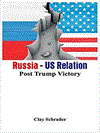

|
|
|
|
|
| Publication |
New Delhi, Alpha Editions, 2017.
|
| Description |
vii, 280p.hbk
|
| Standard Number |
9789386423948
|
|
|
|
|
|
|
|
|
|
|
|
Copies: C:1/I:0,R:0,Q:0
Circulation
| Accession# | Call# | Current Location | Status | Policy | Location |
| 059186 | 327.47073/SCH 059186 | Main | On Shelf | General | |
|
|
|
|
| 17 |
ID:
150188


|
|
|
| 18 |
ID:
151332
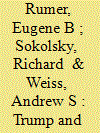

|
|
|
|
|
| Summary/Abstract |
The gap between these two narratives is dangerous. Not only do heightened tensions raise the risk of a military accident or confrontation in Europe and beyond; they are also largely a reflection of deeply entrenched resentments within the Russian national security establishment that are likely to persist well beyond the Putin era. The differences between the United States and Russia run deep, and they are not amenable to easy solutions.
|
|
|
|
|
|
|
|
|
|
|
|
|
|
|
|
| 19 |
ID:
129131
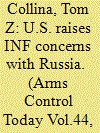

|
|
|
|
|
| Publication |
2014.
|
| Summary/Abstract |
The U.S. State Department confirmed in January that Russia may have breached a landmark arms control agreement by testing a new cruise missile, but has not concluded that Russia violated the accord.
Confirming the details of a Jan. 29 report in The New York Times, State Department spokeswoman Jen Psaki said at a Jan. 30 press briefing that the United States has raised the "possibility of…a violation" with Russia and U.S. NATO allies. The specific U.S. allegation is that Moscow flight-tested a new medium-range, land-based cruise missile. Such a test would run afoul of the 1987 Intermediate-Range Nuclear Forces (INF) Treaty, which permanently bans ground-launched ballistic or cruise missiles capable of traveling 500 to 5,500 kilometers. Rose Gottemoeller, acting undersecretary of state for arms control and international security, has discussed the issue with her Russian and NATO counterparts, Psaki said, adding that "there's still an ongoing review, an interagency review, determining if there was a violation." Psaki indicated that the administration does not view the INF Treaty as being in serious jeopardy.
|
|
|
|
|
|
|
|
|
|
|
|
|
|
|
|
| 20 |
ID:
130831
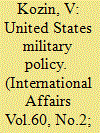

|
|
|
|
|
| Publication |
2014.
|
| Summary/Abstract |
During a visit to the Russian federal nuclear centre at Sarov in February 2012, Vladimir, Putin set the task of long term planning in the sphere of armaments, naming the upper limit: for the upcoming 50 years. Speaking as he met with senior commanders from the defence and security ministries and agencies in the Kremlin on November 19, 2013, the President and supreme commander-in-chief of the Russian federations said: we need to fully conceive the nature and prospects of the politico-military processes that are unfolding in the contemporary world and to clearly understand what potential threats may affect the situation around our country.
|
|
|
|
|
|
|
|
|
|
|
|
|
|
|
|
|
|
|
|
|